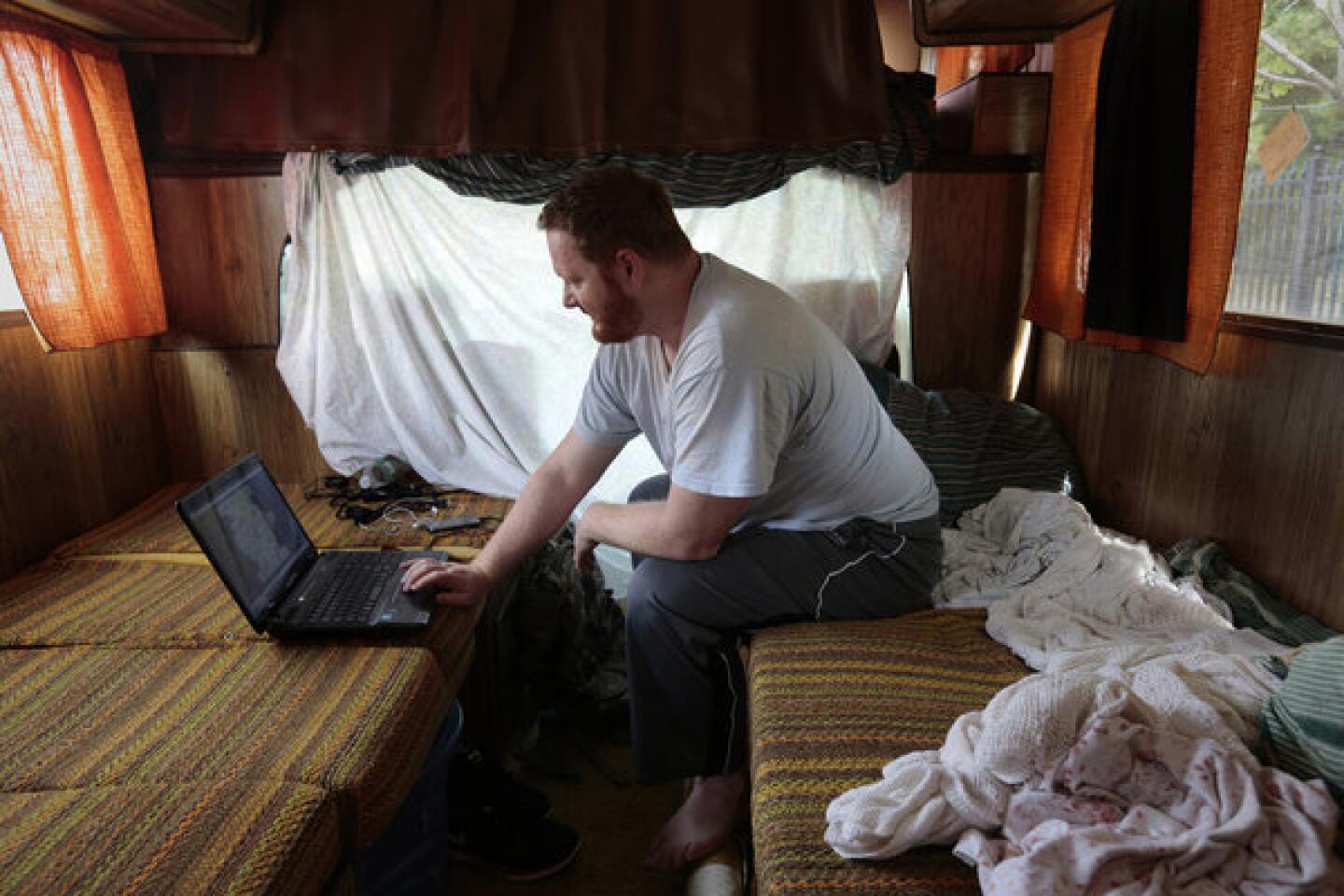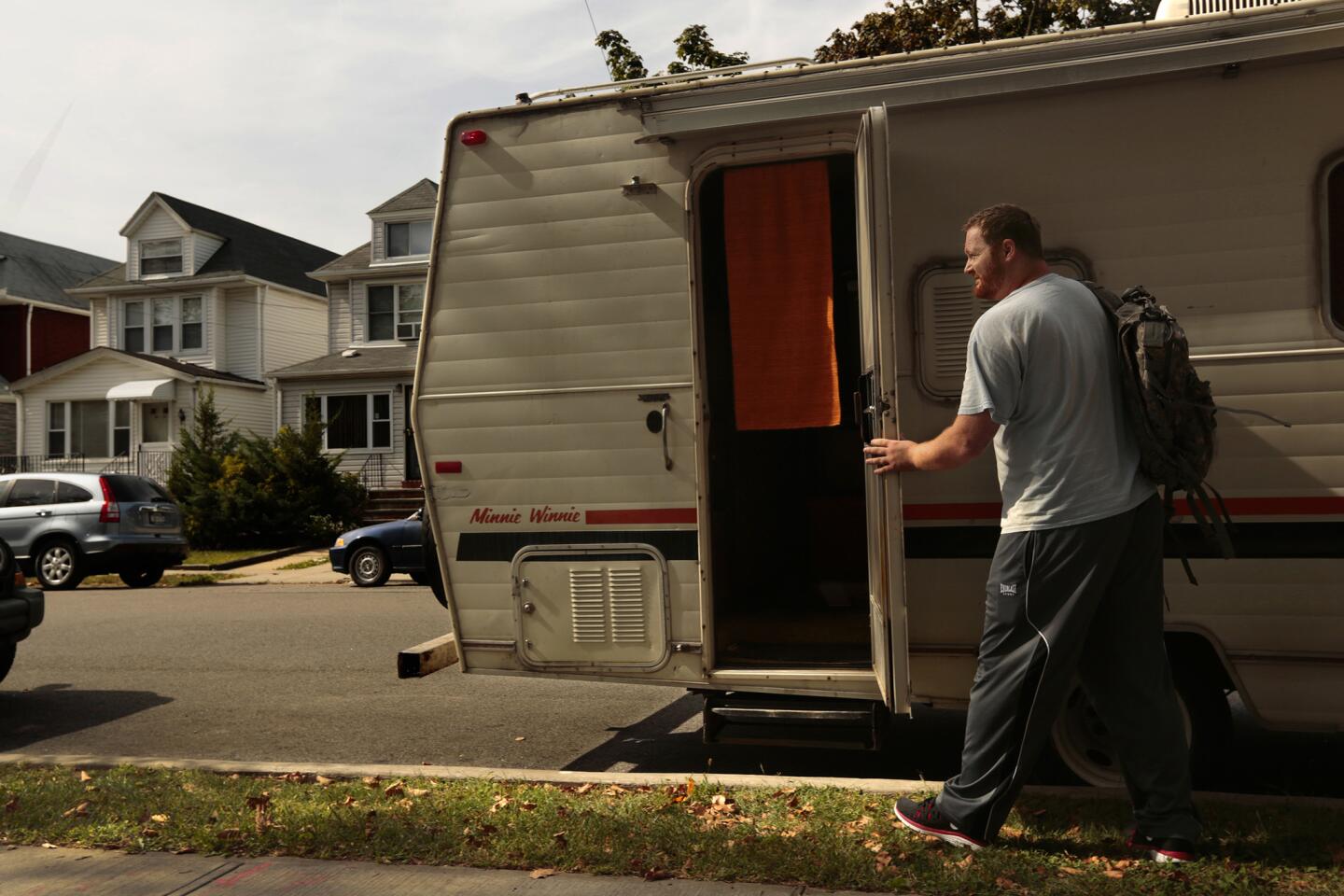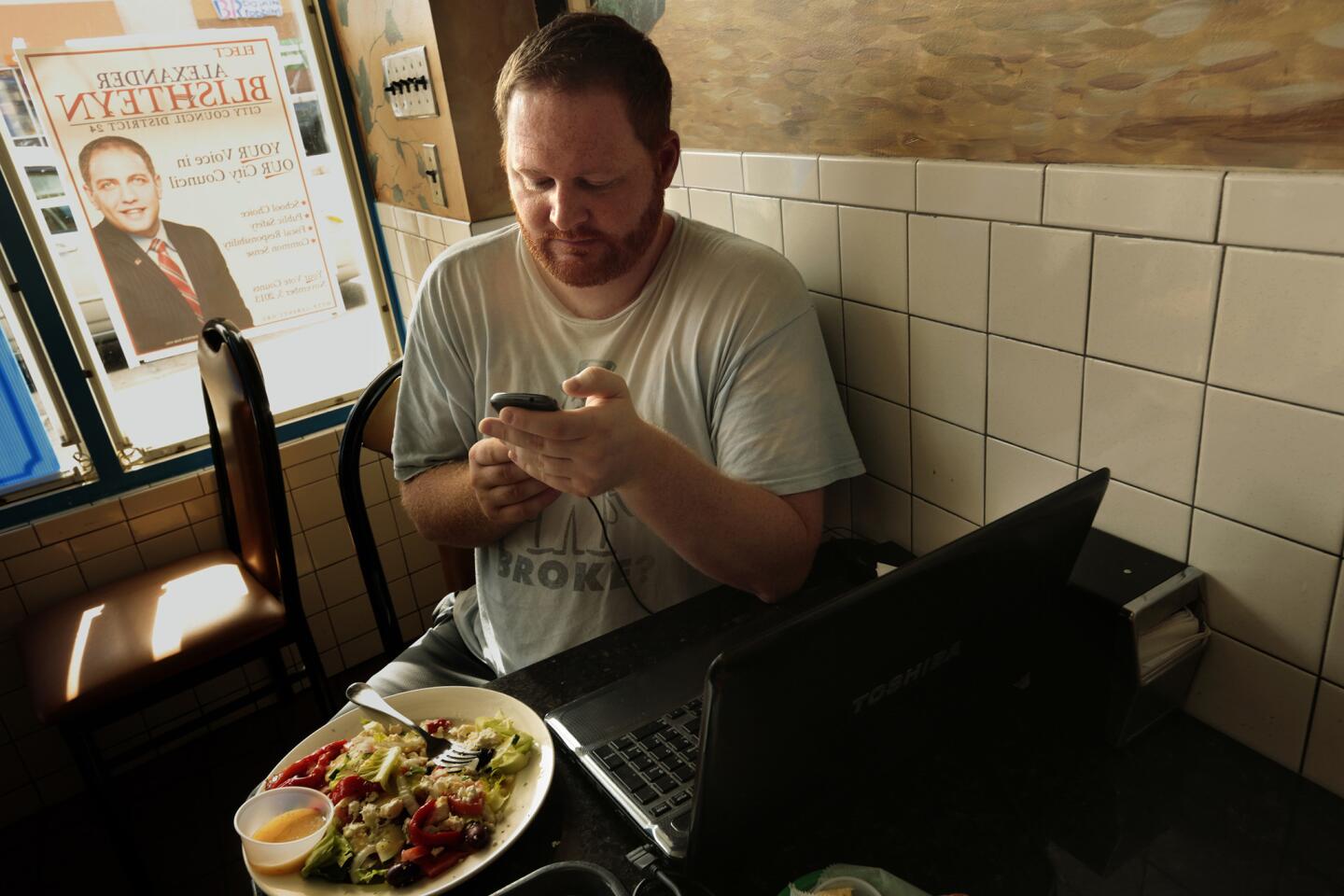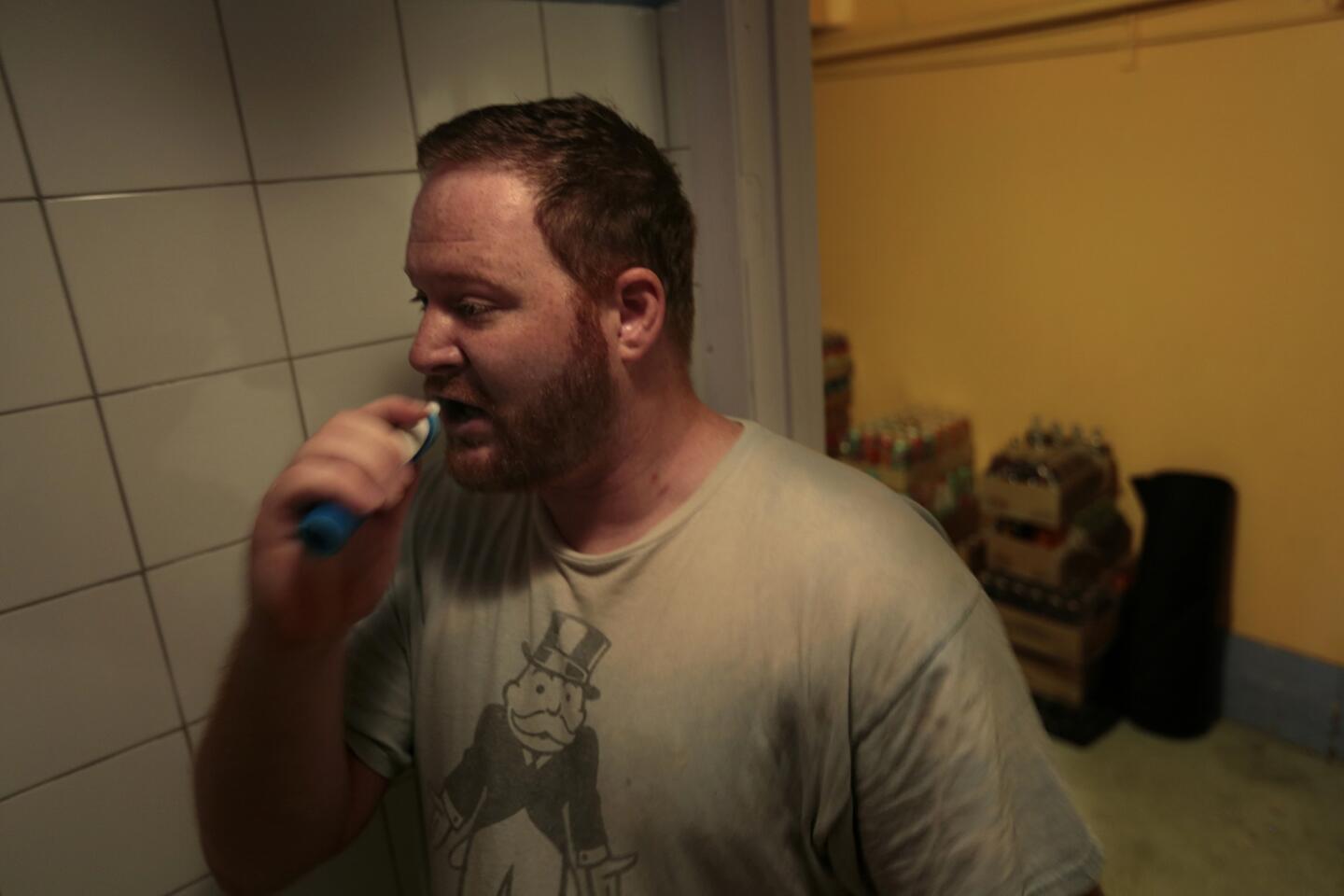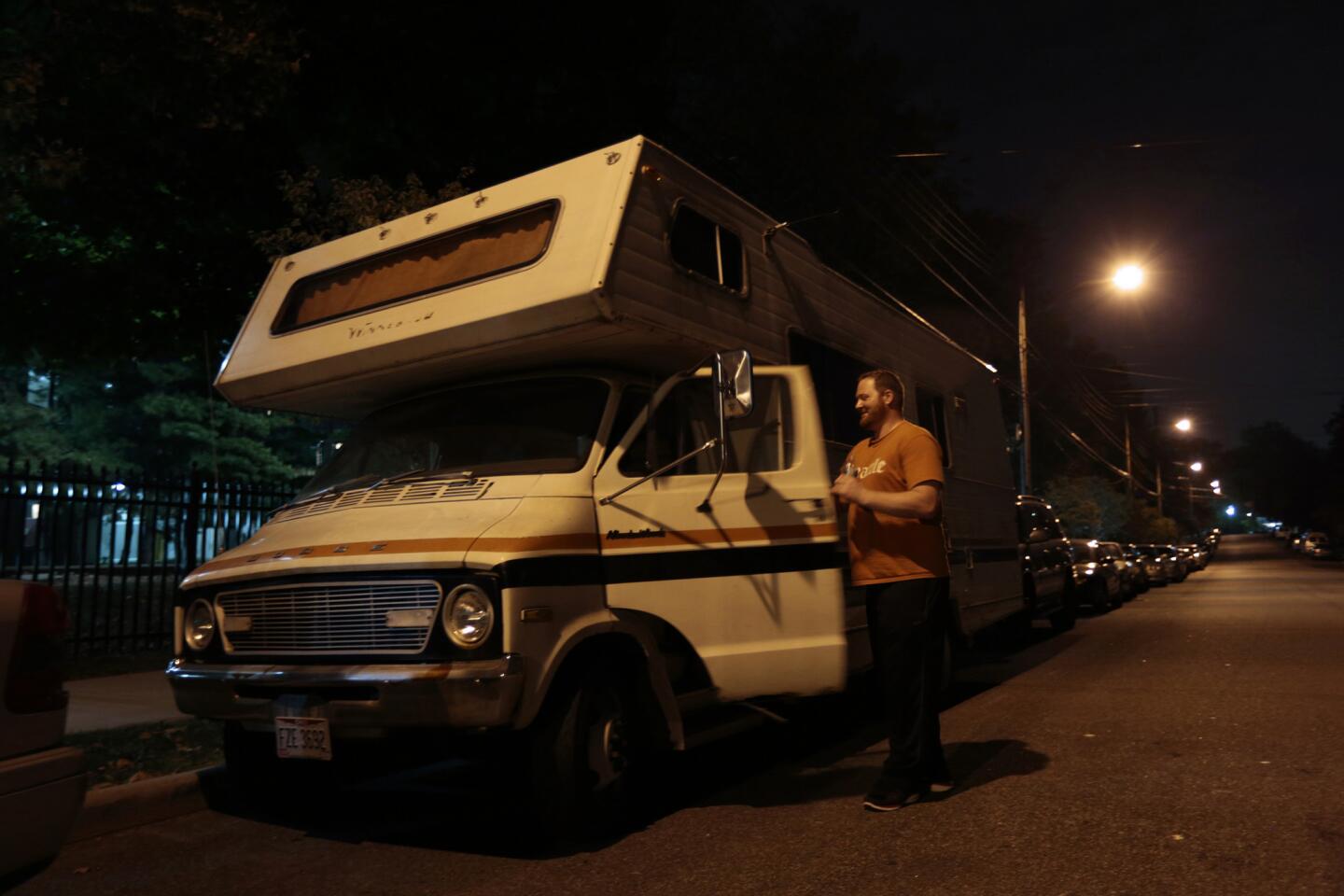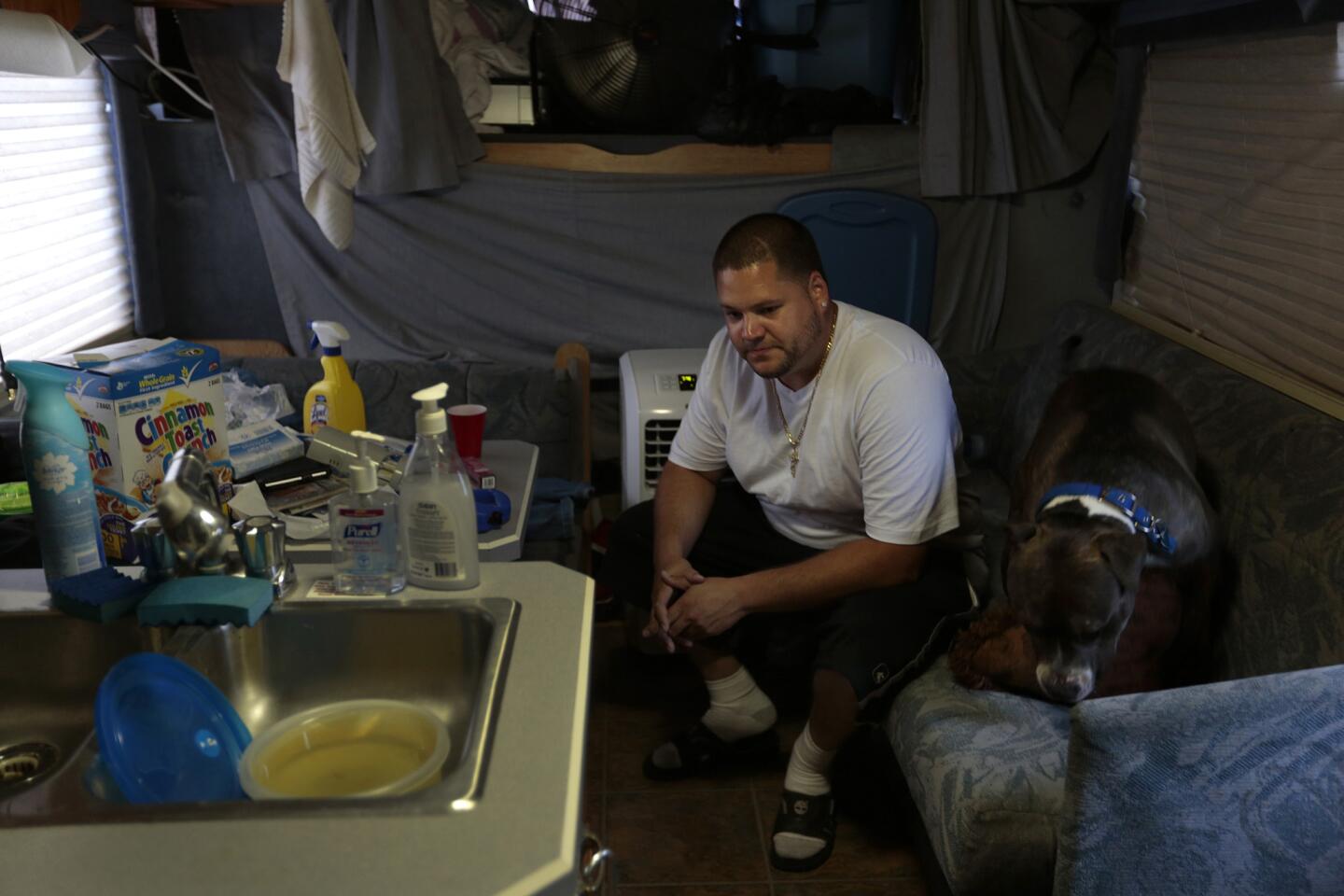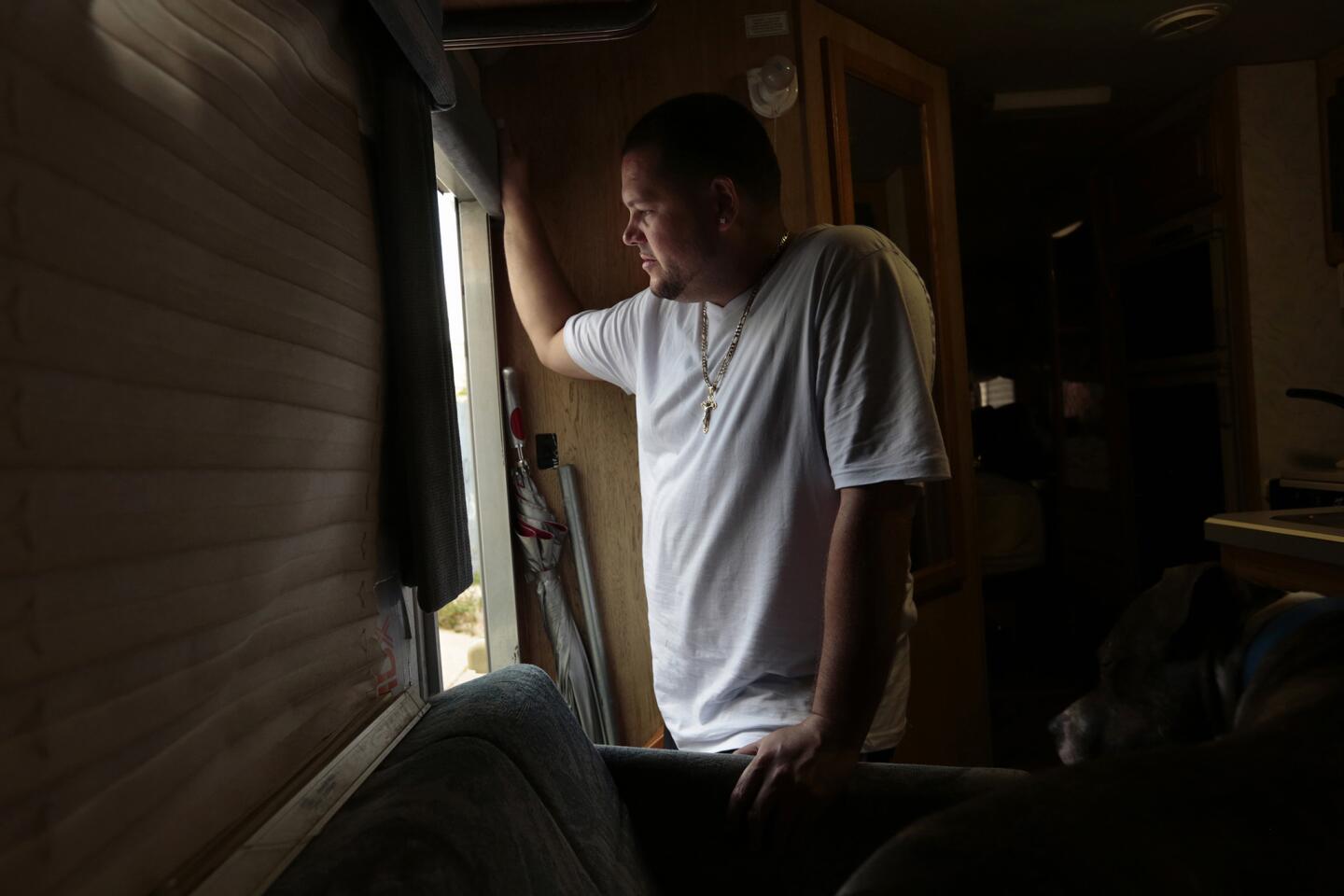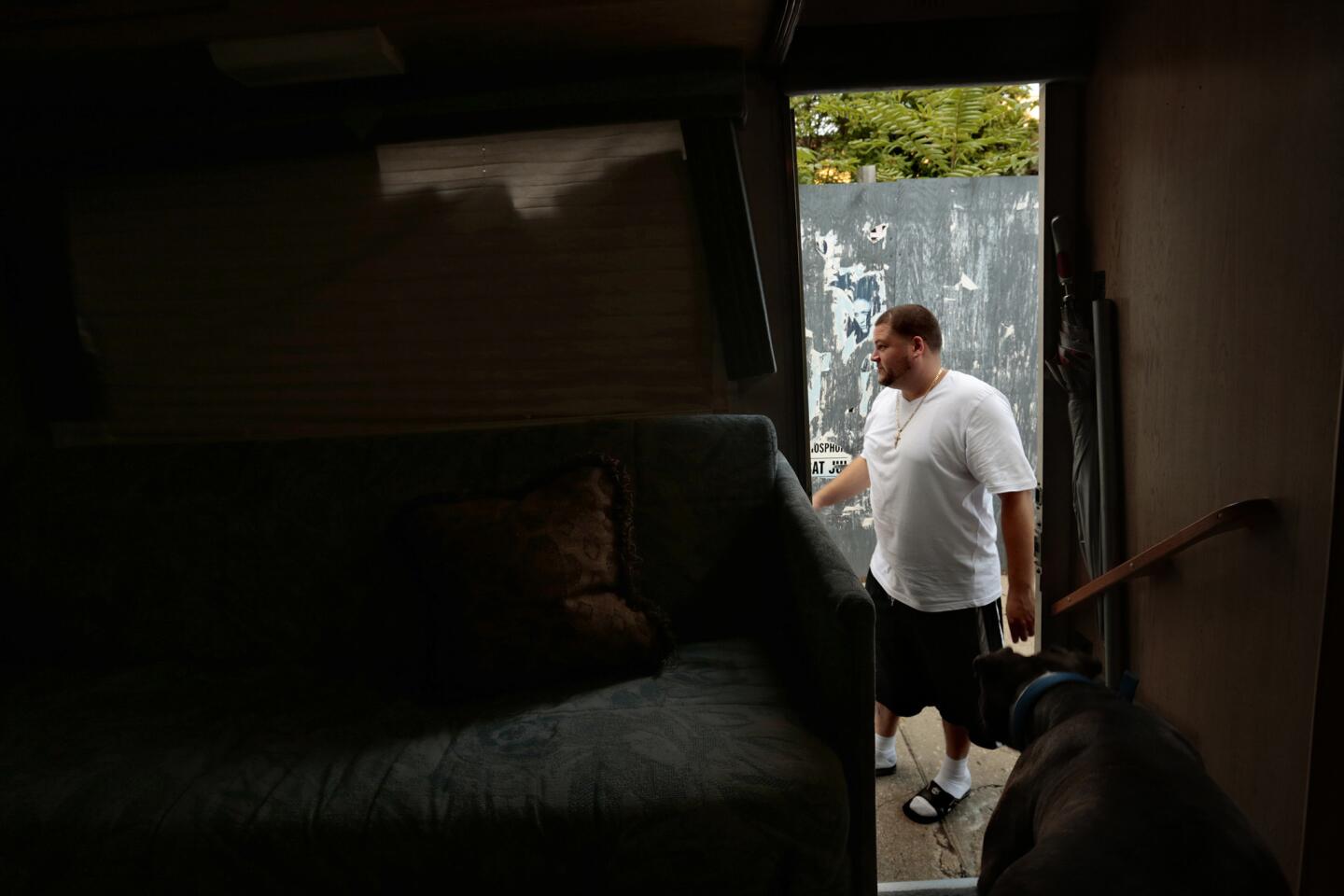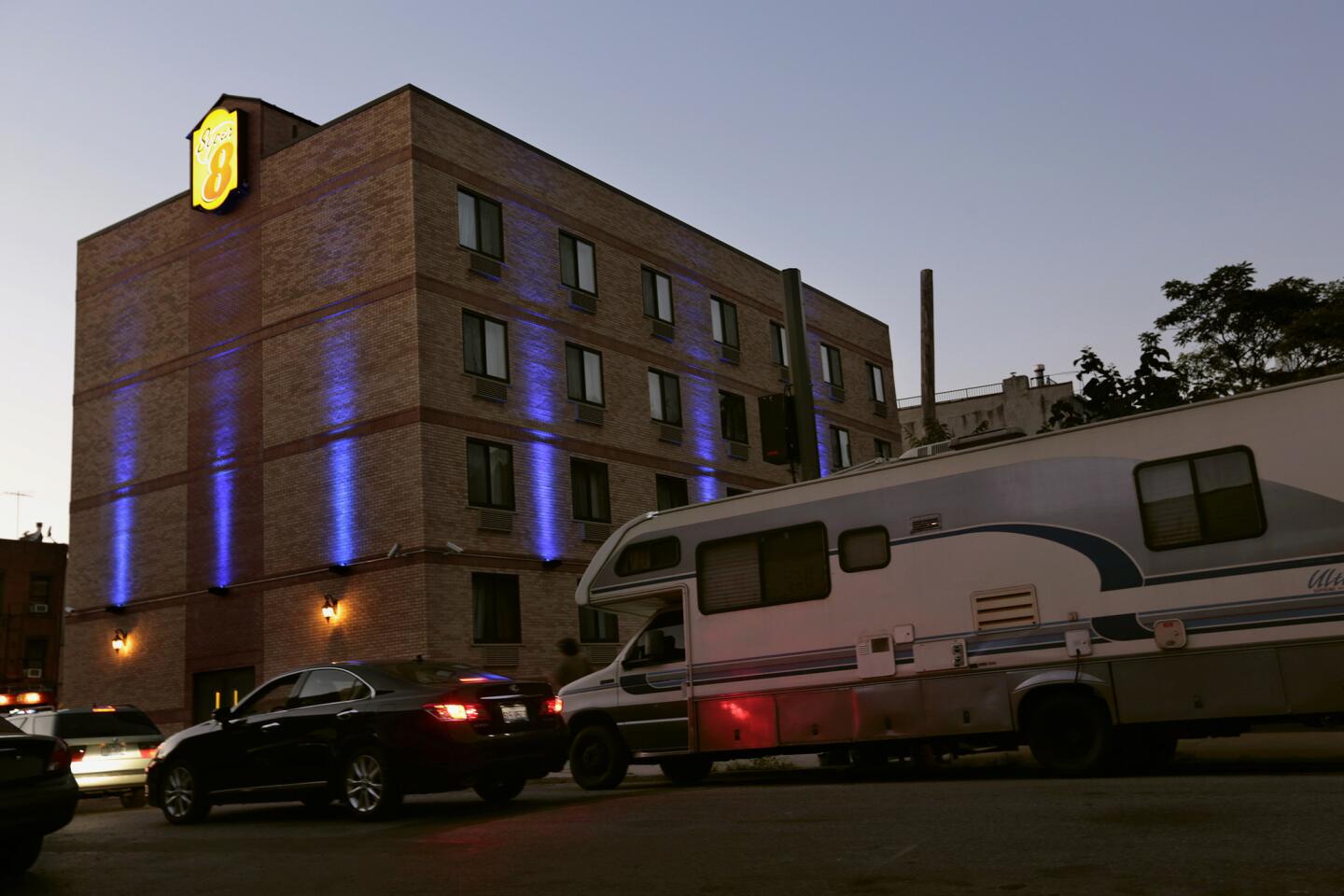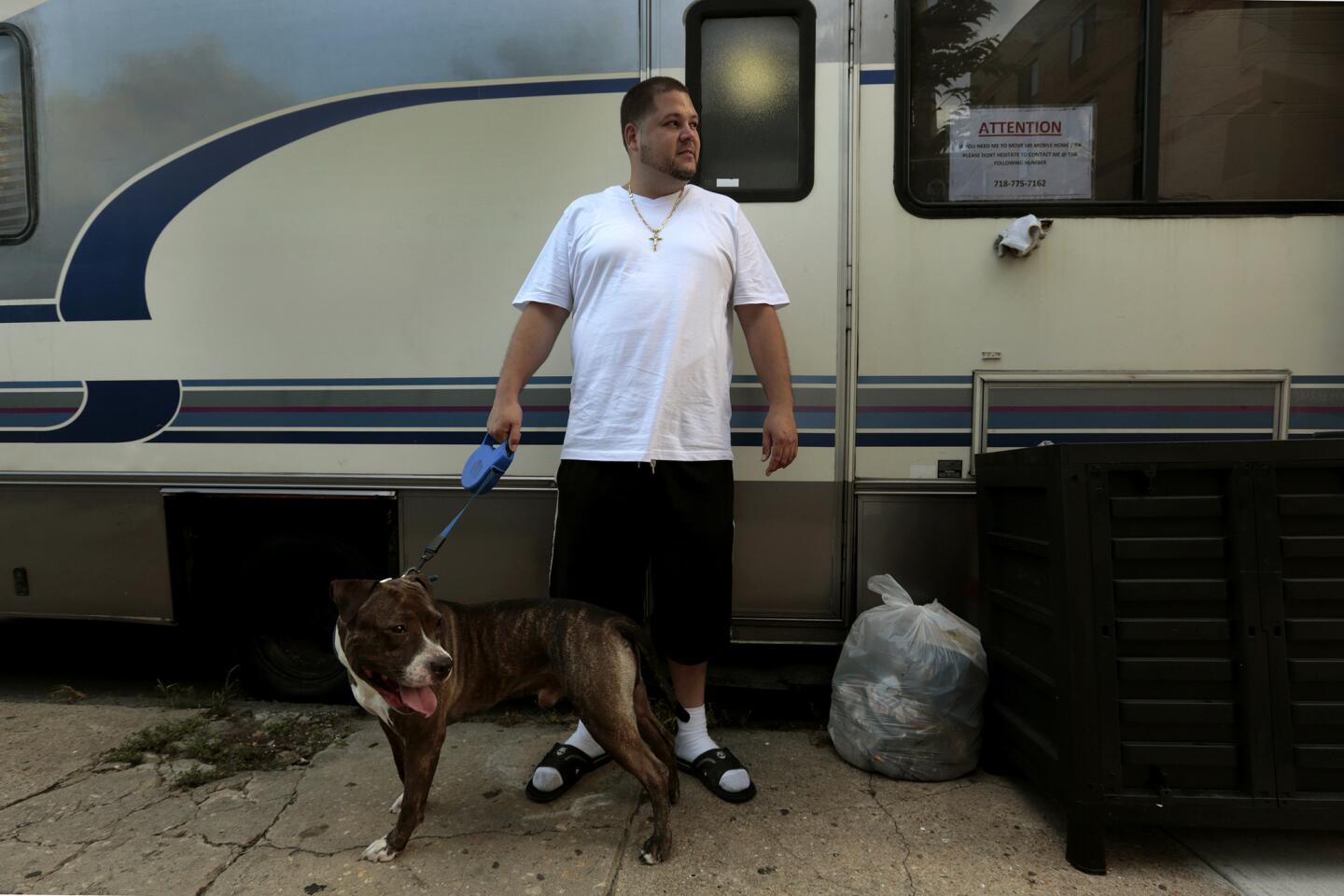In New York, RVs are one answer to soaring rents
NEW YORK — Steven Cintron kicks back on a small sofa a mere couple feet from his kitchen table. The breather from his construction job is welcome, even if cramped like everything else in New York City.
The couch doubles as a bed for his pit bull, Bruno. Cintron’s own queen-size mattress is shoved in the back with the TV, a hunched walk past the mini-fridge, three-burner stove and closet-size bathroom.
Cintron’s roughly 200-square-foot pad isn’t just any tiny apartment in the Big Apple. It’s an RV — meant more for roaming American highways than wedging into parallel parking spots.
As the most expensive city in the country gets even pricier, Cintron and other New Yorkers are taking drastic steps to survive the most brutal real estate market in the United States. They are ditching sky-high rents and buying secondhand recreational vehicles.
“I’ve got everything,” said Cintron, a husky 34-year-old with a close-cropped beard and gold chain, as his fan and portable air conditioner whir. “I’m comfortable here.”
Cintron was looking for a new place to live last spring after splitting up with his girlfriend. Unable to find an affordable apartment that would also allow his dog, he found inspiration in a friend who owns an RV. So he bought a 1996 Gulf Stream Ultra posted on Craigslist for $5,000.
He wound up parking near Brooklyn’s tony Park Slope neighborhood, where he grew up but now can’t afford to rent. A new Whole Foods is sprouting a few blocks from an artisanal pickle store and organic juice bar.
By turning to mobile apartments, RV dwellers are something of real estate pioneers in New York. RVs give New Yorkers a way into hip or exclusive neighborhoods they otherwise might not be able to afford. They don’t have to worry about nagging landlords, rent hikes or upstairs neighbors tap-dancing at midnight.
But there are obvious trade-offs. Getting electricity takes some effort. Heating during the winter can get costly. Mail may need to be delivered to relatives’ places or post office boxes. There’s also the issue of how to hook up sewage lines.
And RVs may not offer much social cachet.
“The ladies aren’t really kicking down the door,” said Rick Hall, who gave up on trying to find an apartment before he moved to New York to study at St. John’s University. Hall bought the RV from a friend when he was still in Ohio and parked his home near the school’s campus in Queens.
New Yorkers have long struggled to find affordable shelter in a city bursting at the seams with more than 8 million people. They have crammed extra roommates into bifurcated living rooms, converted closets into bedrooms and moved into house boats. Greg Kloehn, an artist based in Oakland, won worldwide media attention when he transformed a Dumpster into a miniature bungalow for when he visits the East Coast.
As Wall Street profits have roared back, economists say, the city’s deep-pocketed financial class and foreign investors have driven up real estate prices and rents even as incomes have stagnated in a sluggish economy. Last year, Russian billionaire Dmitry Rybolovlev reportedly paid a record $88 million for an apartment along Central Park in Manhattan.
Renters are paying record amounts too. The average asking rent in New York was $3,105 in the third quarter, up 6% from a previous high in the third quarter of 2008, according to real estate research firm Reis Inc.
New Yorkers on average pay more than double what Los Angeles renters pay ($1,480), and nearly 50% higher than San Francisco renters ($2,113), according to Reis.
The Park Slope neighborhood in Brooklyn, where Cintron grew up, has gentrified quickly in recent years.
The area has become a trendy destination for well-to-do professionals squeezed out of Manhattan by soaring rents. Its leafy streets lined with manicured brownstones are known for being congested with baby strollers.
It is home to political bigwigs such as Bill de Blasio, New York’s mayor-elect, and Charles Schumer, the powerful U.S. senator, who lives along Brooklyn’s treasured Prospect Park. Celebrity denizens reportedly include actors Maggie Gyllenhaal, Patrick Stewart and Steve Buscemi.
Living there costs a premium. For a mere studio apartment, landlords ask as much as $2,000 a month, according to listings on the website StreetEasy.
B. Bryan, 33, may be priced out of Park Slope, but that didn’t stop him from snagging a parking spot just steps from the park.
“Rents are astronomical, so you don’t even have to worry about your rents going up,” Bryan said.
The idea of saving on rent appealed to Bryan, a former New York City employee who said he is out of work on disability. He dropped about $15,000 on a 1994 Thor Industries Pinnacle, including improvements.
Bryan tricked out his portable digs with solar panels, his electricity source. He fills up its 100-gallon tank using a fire hydrant, for dishwashing and use in the restroom.
Inside, he has created a bachelor’s dream. He watches satellite TV and plays video games on two 40-inch flat-screen televisions, one of which hangs near the windshield. He surfs the Internet by using his phone as a hot spot. A camera mounted on the RV’s roof keeps watch.
“Everybody wants to hang out in my RV,” Bryan said. “I have PlayStation in there. Now I have cable. It’s a very comfortable thing.”
And he’s not planted in one place. He takes his children on trips when they visit. Recently they stopped by the East River for a view of the Manhattan skyline and visited the aquarium at Coney Island.
“I just drove out there — it’s like taking your whole house with you,” Bryan said.
Moving requires only gas in the tank and a parking spot. In theory, it’s freedom to live on ritzy Park Avenue on the Upper East Side, or the hipster-chic Williamsburg neighborhood in Brooklyn. But an out-of-the-way commercial area may draw fewer residents’ complaints.
There are, of course, questions over whether living in an RV is legal in New York City, whose red tape often befuddles.
The city’s Law Department offered little clarity over whether RV life was legal in New York. A department spokeswoman said the agency knew of no city laws specifically addressing living in an RV or any prohibition against living in a parked vehicle.
The state Department of Motor Vehicles counted 589 RVs registered to New York City residents in 2012. The agency, which classifies them as “houses on wheels,” does not track how many wind up as primary residences or get parked outside the five boroughs.
Hall, the St. John’s student, takes showers on campus. Before he moved his 1976 Dodge Minnie Winnie to a nearby Veterans of Foreign Wars location, he brushed his teeth at a local pizza joint.
He now gets power with an extension cord from the VFW. The student of homeland security used to read books about terrorism by flashlight.
“It’s not the most convenient thing in the world,” said Hall, 34, an Army veteran who served in Iraq. “But I’ve been in worse.”
The freedom to move in an RV also has a flip side: no permanent place to call home.
Cintron had been living next to a hotel so he could tap its power for $125 a month. But that arrangement ended when he heard a knock on his door.
It wasn’t a curious cop or nosy neighbor. It was the hotel’s manager. Police had told the hotel that his extension cord, even if covered with a mat across the sidewalk, violated city regulations.
Frustrated but undeterred, Cintron settled in a nearby lot. For now, he’s able to stay close to his boyhood home.
“It’s bad out here,” Cintron said. “All the yuppies came in and that changed everything.”
More to Read
Sign up for Essential California
The most important California stories and recommendations in your inbox every morning.
You may occasionally receive promotional content from the Los Angeles Times.
